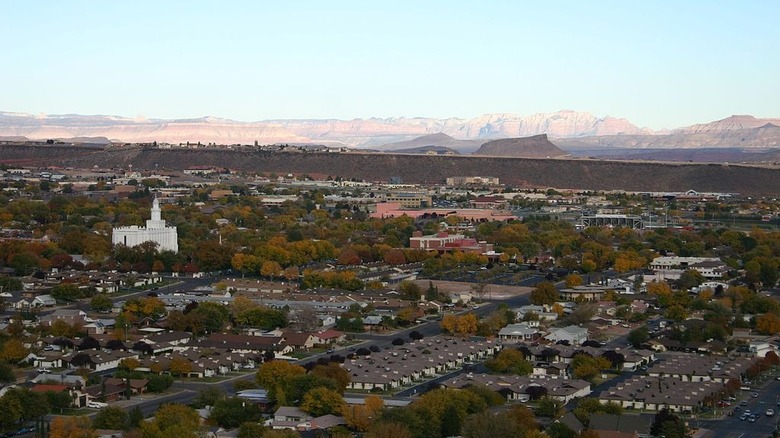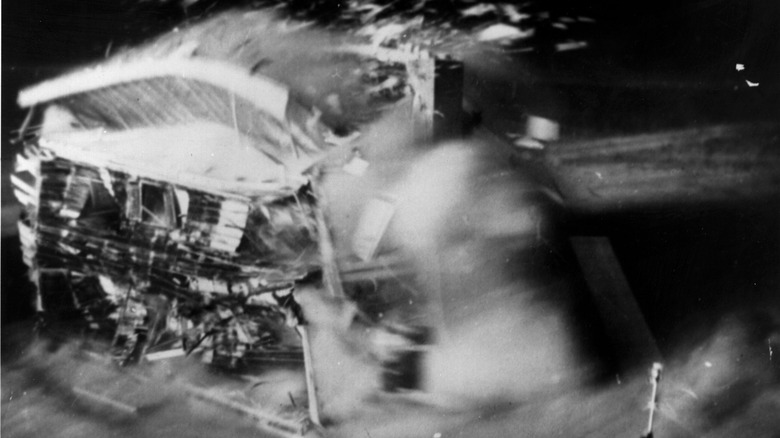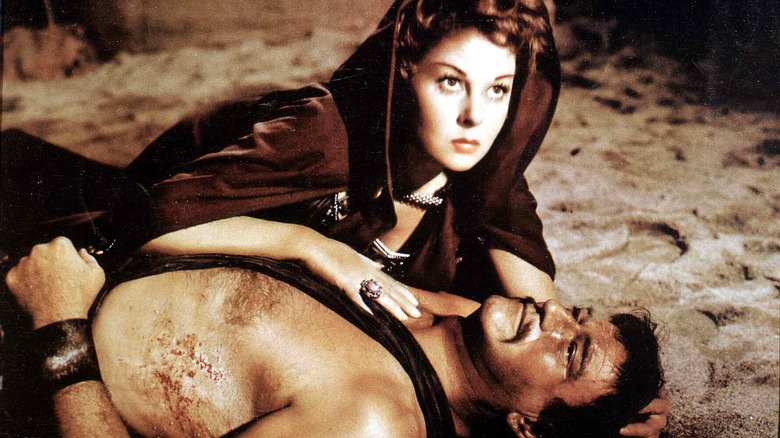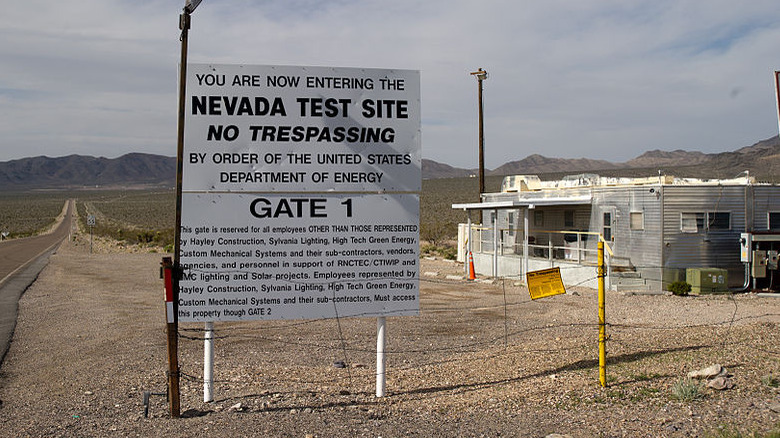The Tragic History Of Nuclear Downwinders
Are you a "downwinder?" If you lived in Arizona, Colorado, Idaho, Nevada, New Mexico, Oregon, North Dakota, South Dakota, Texas, Utah, Washington, or Wyoming between 1942 and 1971, then at some point you were likely exposed to large amounts of nuclear fallout and/or radioactive contamination when the United States openly tested nuclear weapons or allowed the uranium industry to run unchecked. But the term "downwinder" actually originates from the initial testing at the Nevada Test Site just north of Las Vegas during the 1950s and 1960s, when winds carried nuclear fallout from the experimental explosion of nuclear bombs hundreds of miles away. Thousands were affected, and many wound up with cancer.
Some 70 years later, Americans are dealing with a plethora of illnesses due to the testing of nuclear bombs. The government recognizes that those exposed for at least two years between January 21, 1951 and October 31, 1958, and also between June 30 and July 31, 1962, indeed deserve some sort of compensation, $50,000, if their cancer appears on a specific list and if they can provide needed documentation to prove their case. The trouble is that during the nuclear tests, the government failed to track any data among those who might be exposed, those who were exposed, and even the resulting cases of cancer they developed. How in the world did this happen? Read on for the tragic history of nuclear downwinders.
The Nevada Test Site was established during the Cold War era
According to National Geographic, the Cold War was a period between 1946 and 1991 when the U.S. and the Soviet Union participated in an all-out arms race for "world dominance." Atomic Heritage explains that the U.S. government selected Nellis Air Force Gunnery and Bombing Range in the remote desert 65 miles northwest of Las Vegas as an ideal site to build and scientifically test nuclear arms. Although there were some homes in the area, the "rural nature of the site made it difficult" to warn everyone living close to the site.
Worse yet, guidelines for the best days to blast with the least amount of radiation effects were only loosely adhered to. Not only people were at risk, but the dairy products, meat, and vegetables being grown locally were affected as well. Nor did it occur to anyone that those living downwind of the test site in Arizona, Nevada, and Utah would be subject to fallout. Thus, the first atomic bomb was set off on January 27, 1951. It was a real doozy, too, the flash of the explosion being visible in San Francisco nearly 600 miles away — all in the name of "the security of the United States and its allies."
People were told the nuclear tests were safe
According to a 1957 report, population density and other factors were certainly considered when the Nevada Test Site was established. The site "most nearly satisfied" the government as to the safety of the testing. At the time, no explosions were planned "until a determination has been made that its firing will be acceptable under established criteria for offsite radioactive fallout." With such criteria in mind, plans were made to detonate that first nuclear bomb, "Able," in a dry lake bed. Around 100 more would follow in the coming years.
As the U.S. Atomic Energy Commission carried out its testing, the public was assured that the bombs were safe. Brochures claimed the "path of fall-out ... does not constitute a serious hazard to any living thing outside the test site." Today, however, we know that "nearly 150 million curies of radioactive material" would enter the atmosphere due to the bomb testing, roughly 20 times the radiation released in the Chernobyl nuclear accident of 1986. Radiation would eventually taint grass consumed by livestock and vegetables grown in the dirt. And there was absolutely no indication that at least 11,000 people, but perhaps as many as 145,000 people, would eventually die from the fallout.
Americans were actually invited to watch bombs go off
If you were working at the Nevada Test Site, your job included watching the nuclear bombs detonate for "training" and observation. But plenty of civilians saw them, too, driving out to the desert to watch the blasts with their families. In nearby Las Vegas, the party was on. The chamber of commerce handed out flyers showing blasting schedules and ideal viewing spots for blast watchers. In town, "Dawn Bomb Parties" were thrown to herald the arrival of that brilliant flash in the sky while showgirls dressed to simulate mushroom clouds. Meanwhile, the government inexplicably issued "military-style" dog tags to the local school kids.
Certainly, officials must have known there was a chance of illness or injury to those close to the Nevada Test Site. Yet even the paparazzi was invited to a special area ten miles from the site to photograph and film a blast or two in 1952, says History. By then, the observers were wearing protective goggles, which they were allowed to remove after counting to three following the flash, which was some 50 times brighter than light from the sun. India Young wrote of her aunt in Utah who watched a blast from her porch with six friends. Each of them had died from cancer by the 1970s.
The wind blew radioactive fallout over several states
You did not have to be close to the Nevada Test Site to be affected by the nuclear blasts there. A map on Downwinders confirms that people in certain counties in eastern Nevada, southern Utah, and northern Arizona were affected. Jay Truman, who made a "disturbing documentary" on behalf of the downwinders (including himself) submits that nearly every household in St. George, Utah (pictured) had someone who eventually died from cancer. Indeed, the Environmental Protection Agency explains that nuclear weapon detonations can propel radioactive particles upwards of 50 miles into our atmosphere. Those particles that can circulate in the atmosphere "for years" before returning to the ground as fallout, given certain wind and weather patterns.
The Centers for Disease Control says that because fallout remained in the atmosphere, pretty much every American who was alive in 1951 was exposed to radiation. Where you were at the time is critical, since those closest to the Nevada Test Site received the most exposure. But wait: the 1957 report from the Office of Test Information maintained that the first 45 bombs ranged "from less than one kiloton (equal to 1,000 tons of TNT) to considerably less than 100 kilotons." If that isn't confusing enough, consider "Dirty Harry," the bomb set off in 1953 that unexpectedly yielded 20 kilotons above recommended levels. Strong winds carried Harry's fallout straight over to St. George and beyond.
First signs of illness were recognized as early as 1953
Civilians knew something was wrong when sheep being herded near the Nevada Test Site began showing serious radiation injuries in 1953. Humans began showing signs as early as the late 1950s, and the 1957 report verifies that 640 claims for "alleged test-connected damage or injury," were filed. Some 384 were settled by payment to the claimants, but it was noted that "No claim has ever been settled on the basis of alleged biological injury to humans." As people became aware of the dangers of nuclear testing, says Atomic Heritage, some tried to stay indoors during the blasts — not realizing that fallout was contaminating their vegetable crops as well as the grasses their livestock consumed.
Even as the 1957 report was made, it was clear there were "grave effects of radioactivity on personnel" (via the Comprehensive Nuclear-Test-Ban Treaty Organization) at the Nevada Test Site. By 1962 newspapers like the Evening Star in Washington D.C. were reporting that scientists were urging the government to study the effects of radiation poisoning before it was too late. The Partial Test Ban Treaty in 1963 sought to ban further nuclear testing, but instead, the tests increased.
The effect on workers at the Nevada Test Site
According to Twilight Health, some 125,000 people worked at the Nevada Test Site during the Cold War era. They were closest to the blasts, and few knew much about what they were witnessing. Hank Bolden, for instance, was just a 17-year-old soldier when he was ordered to the Nevada Test Site in 1955, sent to an area about 3 miles from a blast which he observed without any protective gear. Although he was told to cover his eyes, Bolden remembered that he could see the bones in his hand from the brightness of the blast. He was also sworn to secrecy and later developed cancer.
Like Bolden, Russell Fjeldsted also observed an explosion in while standing in a trench with others when a bomb was detonated some 5,000 feet distant in 1957. The group bent over and covered their eyes, looking up about 15 seconds later to observe a mushroom cloud. Afterwards, Fjeldsted and the others showered and were told to dispose of their clothing — but not all of them did. Later, he said, milk produced near the blast site was said to contain strontium-90. He also later developed prostate cancer. The National Cancer Benefits Center now helps workers like Bolden and Fjeldsted file compensation claims.
Others were affected by the blasts, including actor John Wayne
Of all of those exposed to radiation from the Nevada Test Site, John Wayne is the most famous. For several months during 1954, Wayne and his crew were filming "The Conqueror" just 100 miles from the site, near St. George, Utah. Writer Sharon Haddock surmises that between the radioactive dust kicked up by horses, truckloads of dirt taken back to the film studio, and the fact that the cast and crew "breathed it in, worked on it and rolled in it for months," it is no wonder that 91 of 220 people on the film came down with cancer.
Interesting Engineering gives a smattering of cancer-related ailments to certain cast members: Actor Pedro Armendáriz committed suicide after developing kidney cancer. Actress Susan Hayward came down with brain, breast, skin, and uterine cancer. Actors Lee Van Cleef, John Hoyt, and Agnes Moorehead each eventually died from various cancers. Director Dick Powell succumbed to lymphatic cancer. Wayne, who first developed cancer in 1964, suffered for many years before he died in 1979. According to The Guardian, a Geiger counter on the set "crackled so loudly Wayne thought it was broken."
The least-known victims: Native Americans
Today, the U.S. Department of Justice says that numerous Native Americans have filed for compensation due to the Nevada Test Site. Ian Zabarte, who speaks for the Shoshone Nation living on some 40,000 square miles between Las Vegas and the Snake River in Idaho, claims the government violated the 1863 Treaty of Ruby Valley by creating the site on tribal land without the Shoshone tribe's "consent or knowledge" and thereby poisoning the trees, plants, and animals used by his people to survive. Whether the tribe was notified in advance remains unclear.
The real trouble, according to Nuclear Princeton, is that the Department of Energy has failed to acknowledge the Natives' generally different lifestyles and diets in assessing the health issues of all who were exposed via "dose reconstructions," a way of estimating how much people were exposed to radiation. Worst of all are the numbers given for those Natives filing for compensation under the Radiation Exposure Compensation Act. Navajo Phil Harrison, who assists victims of contamination, says he was told that of all of the claims paid as of 2020, only 2% came from his own tribe's downwinders. That, he said, "means that we're being denied."
George Bush signed the first downwinder compensation act in 1990
Atomic Heritage notes that throughout the 1970s, downwinders struggled to get the government to recognize that the Nevada Test Site had caused multiple cancer issues and deaths. But although Senator Ted Kennedy sponsored the first Radiation Exposure Compensation Act (RECA) bill in 1979, Congress shot it down without so much as a vote. Fortunately, newspapers across the West finally began reporting on the issue by 1981. But it was not until 1990 that President George H.W. Bush finally signed the RECA into law. According to a statement at the time, the act would provide "compassionate payments" to certain people with certain diseases who could provide proof that they were victims of fallout from the Nevada Test Site. But what did "compassionate" mean, exactly?
As the Downwinder website in Coconino County, Arizona, explains, the RECA "presents an apology and monetary compensation" to downwinder victims. The act stipulates that those who worked onsite could receive $75,000 in tax-free money. Downwinders themselves could receive $50,000. And those who worked in the uranium industry related to nuclear bombs could receive $100,000. It is also possible to file a claim on behalf of a family member who has died, starting with the surviving spouse — who must have been married to the victim for at least one year prior to his or her death.
The U.S. government began accepting claims in 1992
It took two years to begin processing claims for the Radiation Exposure Compensation Act. Of course, claimants were required to provide documentation of their illnesses and also prove that they lived in the area affected by the Nevada Test Site. Today, according to the Huntsman Cancer Institute, that area would include five counties in Arizona, six counties in Nevada, and 10 counties in Utah. Downwinders is one of a few sites that offers an online claim form, but there is obviously more to the application than that.
Another issue with the RECA may have been that news of the compensation was slow to spread. After the expansion of "downwinder eligibility" in 2000 (when the number of affected counties was expanded), the number of claims did not really peak until 2001. But the number of claims has declined in subsequent years, possibly due to the average claim-processing time in 2006 being 339 days. As of August 2021, the total claims filed was 51,928 — and 13,199 of those had been denied, with 436 others pending. And while there is a list of the types of cancer covered, there seems to be no explanation as to how and why these very specific illnesses (and the conditions under which they occurred) were chosen in the original RECA in 1990.
Does $50,000 cover the cost of treating cancer in downwinders?
Nope, it's not even close. The National Cancer Center reports that the average patient paid $43,516.10 for cancer care in the first year alone between 2007 and 2013. And while the RECA has acknowledged that the 50 grand (which, with inflation, would be nearly $100,000 today) "does not completely compensate for the burdens placed upon such individuals," the amount has never increased. And part of that problem is that, according to Atomic Heritage, the government first figured that only hundreds, not thousands, of people would apply for compensation.
There are naysayers out there, too. Take James Conca, a contributor to Forbes magazine, who wrote in 2020 that after approximately 65 years of following "114,270 nuclear weapons test participants," the International Journal of Radiation Biology concluded that soldiers observing nuclear testing were not at more risk for cancer than any other person. Conca apparently didn't read the Las Vegas Sun a few months prior, which reported that Arizona lawmakers were proposing the "Downwinders Parity Act" to include even more victims of the Nevada Test Site.
Downwinders are running out of time to file a claim
It is notable that since 1990, the U.S. government has spent some $1.2 trillion on building and storing nuclear weapons, according to author Stephen Schwartz. Compared to the $2.4 billion that has been spent compensating 38,293 downwinders as of August 2021, that seems like an outlandish amount of money. And when the Senate voted unanimously in 2011 to proclaim each January 27 "a national day of remembrance" for downwinders, it just seemed like adding more insult to injury. But there is more.
Although the money paid to downwinders is "considered mandatory spending," the RECA is scheduled to "sunset," or stop paying compensation, as of July 10, 2022. That means that those alive in 1951 or after who were exposed to radiation and developed cancer will lose their right to file a claim for any money. As recently as March 2021, however, Tina Cordova of the Tularosa Basin Downwinders Consortium pointed out that monitors were set up in New Mexico when the Nevada Test Site was in operation — meaning the fallout from nuclear testing affected more areas and more people than the maps on government sites show. Clearly, the fight for justice is far from over.
What do you do if you are a downwinder
Since 2019, governors of Western states have been lobbying to expand the RECA to include Arizona, Nevada, and Utah in their entirety and also add Colorado, Idaho, Montana, New Mexico, and even Guam. They want more money for victims as well. And with the RECA expiring in 2022, websites are encouraging citizens to contact state and local representatives to expand the time limit of the act.
In the meantime, if you are a downwinder and suspect you have cancer, time is of the essence to file a claim, says The Progress in Clark County, Nevada. Intermountain Health Care's RECA program director Rebecca Barlow estimates the time for processing a claim at three months, even if it is filed on July 9, 2022. Also of course, Downwinders recommends a "cancer-related checkup" every three years for those between the age of 20 and 40, and yearly for those 40 and older. The Health Resources and Services Administration has a list of clinics just for downwinders. For the curious, you can also visit the Nevada Test Site, which is now called the Nevada National Security Site. You must present valid identification, your birthplace, and the name of your employer. Also, no binoculars, cameras, cell phones, tape recorders, or telescopes are allowed.













